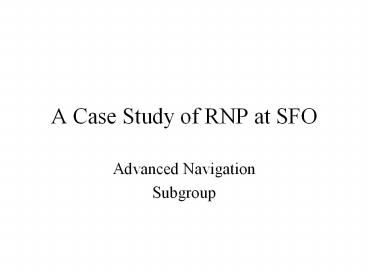A Case Study of RNP at SFO - PowerPoint PPT Presentation
1 / 25
Title:
A Case Study of RNP at SFO
Description:
United and our competitors' schedules demand dual runway operations. When weather is forecast to fall below 3,500 foot ceilings, SFO goes to single runway operation ... – PowerPoint PPT presentation
Number of Views:114
Avg rating:3.0/5.0
Title: A Case Study of RNP at SFO
1
A Case Study of RNP at SFO
- Advanced Navigation
- Subgroup
2
Background - the SFO Airport Air Traffic situation
- The geography - two sets of parallel intersecting
runways, 750 feet spacing between parallel
runways
3
The traffic demands at SFO
- Daily operations - approx 1,300
- Two peak times 1000- 1300 1800- 2100
- Peak times - arrival rates of 45 - 55 per hour
with like high number of departures - Peak demand requires dual runway arrival streams
4
4
5
SFO Today - the impact of Weather
- United and our competitors schedules demand dual
runway operations - When weather is forecast to fall below 3,500 foot
ceilings, SFO goes to single runway operation - As the operating day proceeds, delays build both
at SFO and at outlying stations
6
The Question for this Analysis - Is there an RNP
Approach with good economic payback?
- The RNP Approach must decrease delays by
increasing arrival rates to the 28L/R runways
while maintaining departure rates on 1L/1R in
marginal VMC - Questions
- How large will be the delay reduction benefits?
- What are the associated aircraft equipage costs?
7
RNP - A Primer
- RNP stands for Required Navigation Performance -
expressed in Nautical Miles - For this analysis we will be examining two levels
of RNP - - RNP 0.3 - A requirement for 0.30 nm accuracy
- RNP 0.15 - A requirement for 0.15 nm accuracy
8
2 Scenarios were examined
- An approach requiring RNP O.3
- An approach requiring RNP 0.15
- Both are assumed to provide the same benefit
- The issue is what are the economic implications
of RNP 0.3 Vs 0.15 for attaining these benefits.
9
What is required to attain RNP 0.3?
- An aircraft with an FMS with RNP alerting and
DME/DME - Aircraft capable out of the factory
- A310/320, A330/340,
- B777, B747-400 FANS-1,
- 737NG, latest 757/767
10
What is required to attain RNP 0.15?
- An aircraft with dual advanced FMS with RNP
alerting capability and GPS - Aircraft capable out of the factory
- B777, 737NG, latest 757/767
- A319/320 and A330/340 in 2001/2002
11
A key issue - Percent of aircraft RNP equipped
for ATC to sanction the approach?
- For this analysis we assumed a base case of 75
equipage to initiate the procedure - Today SFO operations fall short of 75 of RNP
0.15 and 0.3 capable aircraft - To reach the critical 75 aircraft either must be
retrofitted or replaced by new capable aircraft
12
Approach to the Analysis
- Developed timelines and costs of attaining 75
equipped RNP capable aircraft, through - retrofit
- replacement of retired aircraft
- purchase of new for growth (assumed new aircraft
RNP capability provided in aircraft base price). - Compared costs to the benefit of RNP, with the
value of reduced delays 25 per delay minute (and
alternatively 50 per delay minute)
13
Year 2000 SFO Airplane Types
14
(No Transcript)
15
RNP 0.3 Fleet Equipage
- Standard Aircraft - Many Require FMC Upgrade
- requiring Retrofit - 50/65/80
- FMC Retrofit Cost - 80k/125k/200k
- Out-of-service costs - 0/0/50k
- Time frame to complete retrofit in years -1/2/2
- No Classic Retrofit
16
RNP 0.15 Fleet Equipage
- Standard Aircraft - All Require FMC Upgrade and
GPS installation - FMC Retrofit and GPS installation Cost -
300k/500k/800k - Out-of-service costs - 0/75k/125k
- Time frame to complete retrofit in years -10
years/5 years/4 years - No Classic Retrofit
17
Benefits - Reduced Delays in Marginal VMC
- Summer Stratus marginal VMC ceilings - 750 feet
to 2000 feet - SFO weather analysis - About 13 of flights are
at MVMC - RNP Approach will allow operations at ceilings of
1,200 feet initially, lowering to 1,000 and 750
feet
18
of MVMC flights Benefiting from RNP
- of MVMC Flights benefiting
19
Advanced NavDelay Reduction Model
Yr................ 2007
2020
20
Advanced Nav--RNP.3 DME/DME WITH RETROFIT Tornado
Diagram
1) of MVMC Captured--Annotation--See page 9
21
Advanced Nav Cumulative Probability Distribution
0 NPV indicates fleet equipage threshold not
reached by 2015
Min Equipage Yr.............. 2008 2014 2009 2002
Benefit-Cost Ratio 0.7 174.8 377.6 2.9
22
Advanced Nav--50 per Delay Minute Cumulative
Probability Distribution
0 NPV indicates fleet equipage threshold not
reached by 2015
Min Equipage Yr.............. 2008 2014 2009 2002
Benefit-Cost Ratio 1.2 349.7 755.2 5.9
23
RNP 0.15 GPS--Sensitivity to Retrofit Costs
Base Case Retrofit Costs 675K 500K
equipment 100K crew training 75K out-of
service Retrofit Cost where NPV equals No
Retrofit Program, 36M 260K A 31
Benefit/Cost Ratio would require a retrofit
cost 140K.
No Retrofit Program 36M NPV
24
SFO RNP Conclusions
- This approach has positive economics if it can be
performed with RNP 0.3 DME/DME equipped aircraft - The base case - a 94 m Net Present Value for
benefit of 25/delay minute - Retrofit reaches 75 threshold in 2002
- A benefit-cost ratio of 3.0
25
SFO RNP Conclusions
- IF RNP 0.15 GPS/GPS is required the approach
benefits do not have positive economics to
justify retrofit - Requirement to accomplish retrofit on D checks
pushes attainment of 75 equipage to 2008 - Net Present Value is (50 m), with a 0.7
benefit/cost ratio - Retrofit costs would have to be less than 260K
to breakeven in the RNP 1.5 case - If delay costs are increased to 50/minute, the
RNP 0.15 has positive NPV and 1.2 benefit/cost
ratio































